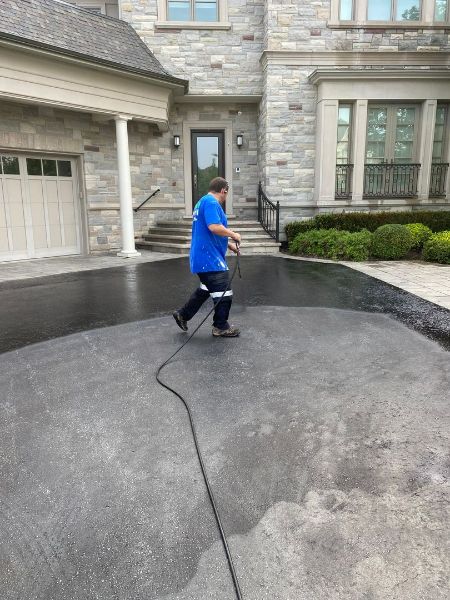Maximize Investment Returns: Angled Car Park Perfection with Asphalt Sealing
Wiki Article
Warm Mix Asphalt: A Lasting Solution for Sidewalk
Warm Mix Asphalt (HMA) has actually emerged as a leading lasting option for pavement services, supplying a myriad of ecological benefits and ingenious modern technologies. As the need for eco-friendly construction techniques grows, discovering the nuances of HMA's sustainability can offer useful insights right into the future of sidewalk solutions.Ecological Benefits of Warm Mix Asphalt

Additionally, Hot Mix Asphalt helps to mitigate urban heat island results. Its dark shade absorbs sunshine, minimizing the quantity of warmth reflected back right into the ambience contrasted to lighter-colored sidewalks. This can lower ambient temperatures in urban areas, lowering the demand for a/c and inevitably decreasing energy intake.
Additionally, Hot Mix Asphalt contributes to improved stormwater monitoring. Its permeable nature enables water to penetrate the sidewalk and recharge groundwater supplies, reducing runoff and the danger of flooding. These ecological advantages make Hot Mix Asphalt a sustainable choice for leading roadways and highways.
Energy Efficiency in HMA Manufacturing
Is energy effectiveness a vital variable in the manufacturing of Warm Mix Asphalt (HMA)? Power plays a significant duty in the production of HMA, influencing both cost and environmental sustainability. One vital aspect of energy performance in HMA manufacturing is the use of warm mix asphalt (WMA) innovations.In addition, innovations in plant technologies have resulted in more energy-efficient HMA production procedures. Modern plants are designed with features like recycled asphalt pavement (RAP) processing capabilities, reliable heater systems, and improved insulation, all contributing to power financial savings. By optimizing power use in HMA production, the industry can decrease its carbon impact while keeping premium pavement products. Energy efficiency is, as a result, a critical factor to consider in making sure the sustainability of Hot Mix Asphalt manufacturing.
Recyclability of Hot Mix Asphalt
The recyclability of Hot Mix Asphalt (HMA) is an essential facet of its sustainability and lasting ecological impact. HMA is among the most recycled products in the United States, with over 100 million lots of reclaimed asphalt pavement (RAP) being reused each year in new sidewalk construction. Recycling HMA uses numerous environmental advantages, such as decreasing the need for virgin materials, decreasing power usage during manufacturing, and reducing the quantity of waste sent to landfills.The procedure of reusing HMA involves crushing the existing sidewalk, crushing it into smaller sized items, and blending it with new aggregate and asphalt binder to produce a recycled mix. This recycled mix can usually execute as well as or perhaps better than standard HMA, while calling for fewer resources and producing lower greenhouse gas emissions. By incorporating RAP right into brand-new pavement tasks, road agencies can conserve all-natural resources, decrease costs, and decrease the environmental footprint of roadway building and upkeep tasks. Overall, the recyclability of HMA plays a significant role in promoting lasting methods within the sidewalk sector.

Long-Term Performance of HMA
Asphalt sidewalks demonstrate sturdiness and strength over an extensive period, mirroring the long-term efficiency of Hot Mix Asphalt (HMA) The durability of HMA can be credited to its capability to endure hefty traffic loads, severe climate condition, and the impacts of aging. Studies have actually revealed that well-designed and effectively created HMA sidewalks can last for twenty years or even more with routine maintenance. The key to maximizing the long-lasting efficiency of HMA depends on using premium materials, complying with finest methods in building and construction, and executing efficient upkeep strategies. Proper drainage, regular inspections, and timely repairs are necessary for protecting the structural stability of HMA pavements gradually. Furthermore, improvements in HMA innovation, such as using polymer-modified binders and warm mix asphalt, have even more enhanced the toughness and regrading longevity of HMA pavements. By prioritizing top quality building and upkeep practices, HMA remains to show itself as a sustainable and cost-effective option for long-lasting pavement infrastructure.
HMA: Resilience and Sustainability
Showing both sturdiness and sustainability, Hot Mix Asphalt (HMA) has actually come to be a keystone in the construction of lasting pavement facilities - commercial parking lot paving. HMA's toughness comes from its capability to hold up against hefty lots, rough climate conditions, and high traffic quantities, making it a trusted selection for highways, highways, and airport terminal runways. The structure of HMA, which usually includes accumulations, binder, and filler, plays a crucial duty in improving its longevity and resistance to use and tear
Additionally, HMA's sustainability exists in its recyclability and energy-efficient manufacturing process. The ability to recycle recovered asphalt pavement (RAP) in new HMA blends minimizes the need for virgin products and minimizes the environmental effect of pavement construction and upkeep. Furthermore, the energy performance of creating HMA hinges on its lower blending temperatures contrasted to various other sidewalk products, causing lowered energy consumption and greenhouse gas discharges.
Final Thought
In final thought, warm mix asphalt (HMA) offers a sustainable service for sidewalk with its ecologically pleasant characteristics. HMA's recyclability, energy performance in production, and long-term durability make it an environment-friendly option for road building.
HMA is one of the most recycled materials in the United States, with over 100 million lots of redeemed asphalt sidewalk (RAP) being reused each year in brand-new sidewalk construction.The process of reusing HMA entails crushing the existing sidewalk, crushing it into smaller items, and mixing it with brand-new aggregate and asphalt binder to develop a recycled mix.Asphalt pavements demonstrate longevity and strength over an extensive period, showing the lasting performance of Warm Mix Asphalt (HMA) In addition, advancements in HMA technology, such as the usage of polymer-modified binders and warm mix asphalt, have actually additionally boosted the sturdiness and long life of HMA pavements. The capability to recycle recovered asphalt pavement (RAP) in brand-new HMA combinations reduces the need for virgin materials and lessens the environmental effect of pavement building and construction and upkeep.
Report this wiki page